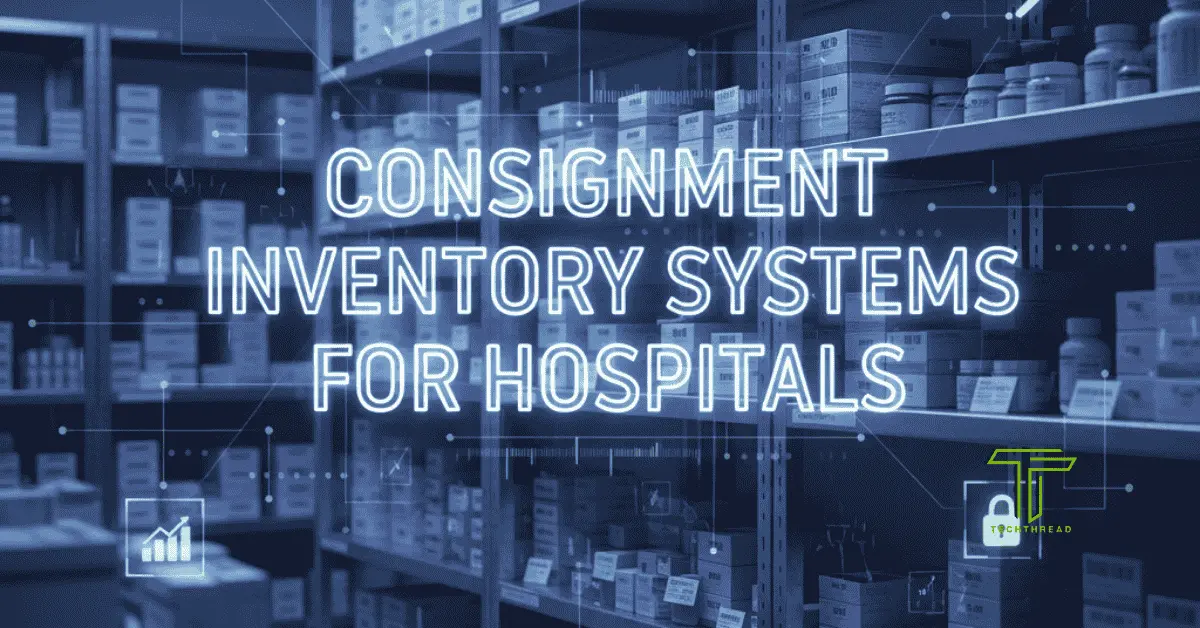A Complete Guide to Consignment Inventory Systems for Hospitals
Inventory management in hospitals is a critical component of smooth hospital operations. Whether it’s life-saving medical supplies or everyday equipment, hospitals need to ensure that they have the right supplies at the right time. However, managing these supplies can be challenging due to fluctuating demand and budget constraints. This is where consignment inventory systems come into play.
For healthcare facilities, consignment inventory systems allow hospitals to manage inventory more efficiently by only paying for items as they are used, rather than buying them upfront. For those looking to delve deeper into how this system works in healthcare settings, a book on consignment inventory systems for hospitals can offer valuable insights.
In this blog, we’ll explore the key aspects of consignment inventory systems, their benefits, components, and challenges, along with what to look for in educational resources like books on the subject.
Table of Contents
What is a Consignment Inventory System?
A consignment inventory system is an inventory model where the hospital does not own the medical supplies or equipment until it is used. The supplier retains ownership of the products while they remain in the hospital’s possession. Only when a product is consumed, used in a procedure, or sold is payment made to the supplier.
This system is commonly used in hospitals to manage high-value medical items, such as surgical instruments, implants, and consumables like bandages and syringes. This approach ensures that hospitals only pay for the goods they need when they need them, alleviating the upfront financial burden and allowing funds to be allocated to other critical areas.
For healthcare professionals looking to implement this system, it’s important to understand the fundamental workings of consignment inventory, its pros and cons, and how it fits into the hospital’s overall supply chain management.
The Benefits of Using a Consignment Inventory System in Hospitals
Implementing a consignment inventory system in hospitals brings several important advantages. For both small healthcare facilities and large hospitals, this system can significantly improve cost-efficiency, streamline operations, and ensure that the right supplies are available when needed.
Cost Reduction and Better Cash Flow Management
One of the biggest benefits of a consignment inventory system is that it reduces the need for large upfront payments for medical supplies. Instead of making a full payment to suppliers for inventory, hospitals pay for items only when they are consumed. This allows hospitals to manage cash flow more effectively and frees up funds for other critical needs, such as staffing and patient care.
Reduced Risk of Stockouts and Overstocking
A consignment system helps minimize both overstocking and stockouts. In a traditional inventory system, hospitals might over-order to ensure they don’t run out of critical supplies, leading to excess inventory and higher storage costs. With a consignment system, hospitals only have to pay for what is used, allowing suppliers to manage stock levels and ensure there are no shortages when items are needed.
Improved Inventory Management and Space Optimization
Hospitals can reduce the amount of space needed for inventory storage since they only keep essential supplies on hand. This not only helps improve inventory management but also leads to better use of available storage space in hospitals, which is often at a premium.
Simplified Procurement Process
With consignment inventory, hospitals don’t need to track every single transaction and purchase manually. The responsibility of tracking the items and reordering supplies rests with the supplier, freeing up hospital staff to focus on other important tasks like patient care and administrative duties.
Key Components of a Consignment Inventory System in Healthcare
To effectively implement a consignment inventory system, hospitals need to consider several essential components that form the backbone of this model. These include vendor relationships, technology integration, and effective management practices.
Vendor Relationships and Supplier Partnerships
One of the most critical components of a successful consignment inventory system is establishing strong relationships with vendors. In the consignment model, the supplier retains ownership of the goods until they are used, which means they are heavily involved in inventory management. Hospitals need to ensure that they partner with trustworthy suppliers who can deliver high-quality products consistently and on time.
Communication between the hospital and the supplier is key to maintaining a smooth operation. This collaboration ensures that inventory levels are maintained correctly, and the right products are available when needed. Additionally, well-established relationships with suppliers often lead to favorable terms for hospitals, such as discounts or flexible payment arrangements.
Integration of Technology for Real-Time Tracking
With the advancement of technology, tracking inventory in real-time has become more efficient. For hospitals, integrating an inventory management system that supports RFID tags, barcodes, or automated tracking helps maintain visibility over inventory levels. Technology integration allows hospitals to monitor the consumption of supplies, make data-driven decisions, and reduce human error.
An effective consignment inventory system uses software that updates stock levels automatically when items are used. This not only reduces the risk of running out of critical supplies but also provides hospitals with detailed reports on usage patterns, helping them predict future inventory needs and optimize stock levels.
Effective Staff Training and Management
Managing a consignment inventory system requires well-trained hospital staff who understand how to work with the system. From nurses to administrative personnel, every member involved in inventory management must know how to track and report stock usage. This involves training hospital staff on using the system, managing product returns, handling restocking, and collaborating with vendors to resolve any issues related to the inventory.
Ongoing training programs are necessary to ensure that staff are up to date with new technologies and procedures, ensuring smooth system operation and preventing disruptions in supply chain management.
Common Challenges Faced by Hospitals Using Consignment Inventory Systems
While consignment inventory systems offer several benefits, they also come with challenges that need to be addressed for successful implementation.
Complexity in Inventory Tracking and Reporting
One of the most significant challenges faced by hospitals using consignment inventory systems is ensuring accurate tracking. Given the volume of items in a hospital’s inventory and the constant flow of supplies, keeping track of every product can become complex. Mistakes in tracking or discrepancies between actual usage and records can lead to stockouts or overstocking, both of which can disrupt hospital operations.
Using automated inventory management software can help streamline this process and reduce human error. However, ensuring that the system is properly integrated with hospital workflows is essential to its success.
Dependence on Suppliers for Timely Restocking
Although consignment inventory systems reduce upfront costs for hospitals, they also increase their dependence on suppliers. If the supplier fails to deliver items on time, it could lead to disruptions in patient care or operations. For hospitals, managing supplier relationships and ensuring timely deliveries is crucial for maintaining consistent levels of critical supplies.
Hospitals must have contingency plans in place for emergency restocking, especially in the case of high-demand medical products that are necessary for urgent medical procedures.
Aligning Consignment Inventory Systems with Financial Practices
Managing a consignment inventory system requires hospitals to align their financial practices with the inventory system. Since ownership of the items remains with the supplier until they are used, hospitals need to track this inventory carefully for financial reporting and auditing purposes.
Hospitals must also ensure that they are following accounting principles that align with consignment models, especially when handling large quantities of high-cost medical supplies. The healthcare finance department must be closely involved in managing inventory costs and payments to suppliers.
The Importance of Educational Resources on Consignment Inventory for Hospitals
Given the complexity of implementing and managing consignment inventory systems, books and educational resources play a vital role in providing healthcare professionals with the knowledge they need to succeed. Whether you’re a supply chain manager, a hospital administrator, or a healthcare professional looking to improve your understanding, a book on consignment inventory systems can serve as a comprehensive guide to the subject.
A good book should cover not only the theoretical aspects of consignment inventory systems but also practical tips, case studies, and advice from professionals who have firsthand experience in implementing these systems. It should also provide an in-depth understanding of how consignment systems work in the context of hospital operations and offer strategies to overcome challenges that arise.
What to Expect in a Book on Consignment Inventory Systems for Hospitals
When searching for a book on consignment inventory systems for hospitals, it’s important to look for several key features to ensure it meets your needs:
Comprehensive Overview of the Consignment Model
The book should provide an in-depth explanation of how consignment inventory works in hospitals, including the roles of hospitals and suppliers, how inventory is tracked, and the financial implications of the system.
Practical Tips and Step-by-Step Guides
Look for books that provide practical tips and actionable steps to implement a consignment inventory system. This includes setting up the system, selecting the right suppliers, and integrating technology to streamline operations.
Case Studies and Real-World Examples
Books that include case studies from hospitals that have successfully implemented consignment systems offer valuable real-world insights into the challenges and benefits of the model.
Recommended Reading for Consignment Inventory in Hospitals
If you are looking for books that provide an in-depth understanding of consignment inventory systems in healthcare settings, consider the following titles:
- “The Healthcare Supply Chain: Best Practices for Healthcare Managers” by Jody M. Schaefer
- “Inventory Management for Healthcare Providers” by Daniel C. Smith
- “Managing Healthcare Supply Chains” by James A. McDade
These resources offer both practical guidance and theoretical insights, making them great choices for healthcare professionals interested in consignment inventory systems.
Conclusion: Embracing the Future of Inventory Management
The consignment inventory system is transforming how hospitals manage their supplies, making it more cost-effective and efficient. By reducing upfront inventory costs and providing flexibility, this model helps healthcare providers focus on patient care while maintaining an efficient supply chain.
A book on consignment inventory systems for hospitals can serve as an essential resource for anyone looking to understand the intricacies of this system and its implementation in a healthcare setting. With the right knowledge, hospitals can overcome the challenges of inventory management and improve their operational efficiency, benefiting both patients and staff alike.
Frequently Asked Questions (FAQs)
How can consignment inventory reduce costs for hospitals?
By only paying for supplies as they are used, hospitals can manage cash flow more efficiently, reducing upfront inventory costs.
Is it difficult to implement a consignment inventory system in a hospital?
While it requires careful planning, technology integration, and training, the process can be simplified with the right resources and tools.
What are the key challenges in managing consignment inventory in hospitals?
Challenges include tracking inventory accurately, managing supplier relationships, and aligning the system with financial reporting practices.
How can technology help with consignment inventory?
Technology, such as inventory management software and RFID, helps track usage in real time, reducing errors and optimizing stock levels.
What are the best books on consignment inventory systems for hospitals?
Recommended books include titles by Jody M. Schaefer, Daniel C. Smith, and James A. McDade, which provide both theoretical insights and practical guidance for healthcare professionals.
Also Read: Anon Vault The Ultimate Guide to Secure, Anonymous Cloud Storage







